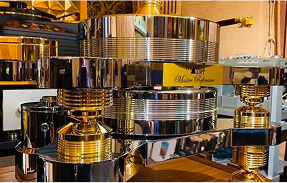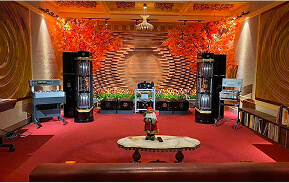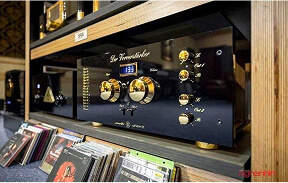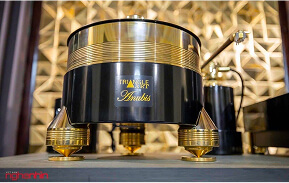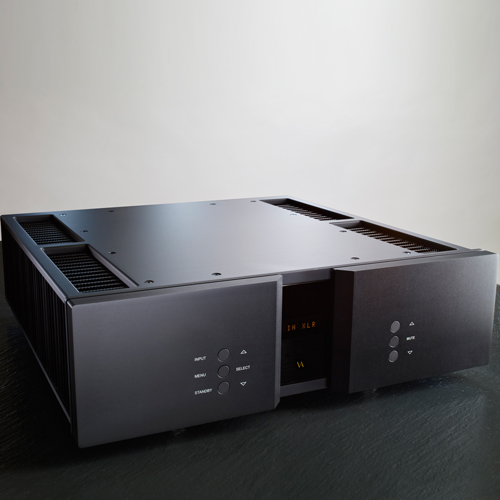
Vitus Audio electronics have impressed me at every trade-show exhibit at which I’ve heard them. VA always shows its strengths and sonic character while allowing the associated loudspeakers, cables, and ancillaries to shine. Typically, I would saunter into the room, get a first impression of the sound, then anchor myself and thoroughly enjoy the music as I worked out fantastic schemes to get the Vitus gear into my system. Cost or logistics didn’t matter -- I had to have them. Luckily, I didn’t have to follow through on my plots; I got my wish, at least for as long as it takes me to prepare this review: I’m listening to Vitus Audio’s SM-010 monoblock amplifiers ($45,000 USD per pair) in my home system.
Every expensive high-end audio component should be a complete package, and Hans Ole Vitus obviously considers this when designing his products. Should the owner of a Vitus SS-010 stereo amplifier require a little more power and the benefits of a monoblock, it can be converted into one SM-010 monoblock. The benefit, according to Vitus, is "the added power and true balanced configuration gets you really close to the SM-101 performance." Just buy a second SS-010, have it converted to mono, or simply another SM-010, and voilà: two Vitus SM-010 monos.
Vitus Audio products are expensive; if an audio component costs as much as a car or a house, its buyer should enjoy its finish and build quality as well as its sound -- we audiophiles see and touch our hi-fi gear as much as we listen to it. Like all VA products, the SM-010 has a lovely case of bead-blasted aluminum with a slightly suede-like texture. Unlike the "here I am" glare of a mirror finish, its matte finish softly reflects light. Both the silver and black finishes are nice, but the unassuming nature of the finish and sweet, tactile feel of the SM-010 keeps engineering aficionados coming back for one more swipe of the finger. Sure, Vitus amps don’t need to be so luxurious, but if they weren’t, they wouldn’t be Vitus amps. When you buy Vitus, you buy luxury and sound.

The SM-010 is very well built and, at 17"W x 5"H x 16.75"D, surprisingly heavy -- each one weighs 92 pounds, no doubt mostly because of the custom-made transformer that occupies about a third of its interior. Hans Ole Vitus told me that his transformers are a very important factor in the sound of his products. Another amp maker told me that transformer design is an art, and that the transformer makes or breaks an amplifier. Vitus must feel similarly -- he builds his own UI-core units. Also under the SM-010’s top plate, in addition to that heavy, expensive iron, are Sanken output transistors and what looks to be VA’s own internal wiring. Vitus has also clearly thought about clumsy audiophiles and children: The top and bottom plates wrap around the side-panel heatsinks, which helps tremendously when positioning the amps, or when children are navigating a maze of audio gear. The binding posts and XLR and RCA input connectors are of extremely high quality.
The SM-010 has two output modes: It produces 40W in pure class-A, or 100W in class-A/B, both into 8 ohms. The amp runs on the warm side, but not ridiculously so. At startup, the SM-010 displays "Init" on its front-panel display. Then, after a few moments, it emits a click that tells you it’s ready for a signal. At this point, the amp is in class-AB mode. Using the display on the front panel, the user must navigate the menu to switch it to class-A. I let the amps warm up in class-A/B for an hour or so, then switched them to class-A for serious listening.
Listening in class-A/B
At startup, the Vitus SM-010s presented an accurate outline of the music, displaying every detail of the whole picture, from the softest background hum of a euphonic guitar-amp tube, to large orchestral blasts with their inherent nuances, despite lacking the full color saturation I heard when the system was warmed up and switched to class-A. In class-A/B, details and bass stood a bit separate from the music. However, it didn’t take long before the amps were in full song.
I listened twice to "America," from The Essential Simon and Garfunkel (CD, Columbia/Legacy C2K 90716). The first time, it sounded a bit cool and distant; the second time, everything was more fleshed out, real, and palpable. Next came an unexpected thrill. I cued up the title track of the Avishai Cohen Trio’s Gently Disturbed (CD, Razdaz RD4607). Cohen’s opening double-bass solo was slightly haunting, but the real treat came when drummer Mark Guiliana entered -- his drums sounded as if they were in the room with me. The SM-010s’ soundstaging was stunning. I could practically see the drums on their riser in the appropriate perspective, behind the rest of the band and slightly muted; the whole album has the feel of a dank, slightly cool jazz club full of stale cigarette smoke. "Forró en Curuipe," from jazz pianist Marcelo Zarvos’s Music Journal (CD, M•A Recordings M055A), opens quickly, with lots of detail and arresting nuance. The Vituses produced a natural, quick-sounding musical spectrum from top to bottom. In this track, the midrange and treble are pushed to the fore. However, without the Vituses’ speed, inner detail, and resolution, this track would fall apart into an incoherent mash. The big drums in this piece were a treat through the SM-010s, their sound decaying naturally into a hollow, cavernous acoustic that revealed their true size.

Listening to keyboardist David Lanz’s cover of Procol Harum’s "A Whiter Shade of Pale," from hisCristofori’s Dream (CD, Narada 46963), revealed the truthful nature of the SM-010s. The detail they revealed was such that I could tell if the drummer was using wood or plastic-tipped drumsticks. Some might question if this is a good thing, and why anyone should even care. When an accurate audio system reproduces the music’s texture, tone, intonation, nuance, decay, initial attack, and purity, it brings the listener closer to the artists’ original intent. The Vitus amps were able to do that without being overbearing, or making the details the stars of the show.
Yet they were never too soft. For example, the sax in "Dancing Mist," from Masabumi Kikuchi’s Poo-Sun (CD, Universal Music UCCJ-4069), wasn’t hard or blatty, which could have indicated a lack of resolution. Instead, the treble was sweet, delicate, palpable, and appropriate, and the SM-010s reproduced the trumpet with a realistic sense of bite. There wasn’t too much or too little of anything -- it was much like listening to live, unamplified music.
The SM-010’s midrange never drew attention to itself, yet was the keystone of the amp’s sound, producing a tonally pure picture of the music. Many fans of tubes find fault with solid-state amps, claiming that they just don’t sound like music. I disagree. The Vitus amps got that midrange richness often heard with tubes, but did so with solid-state clarity -- a wonderful feat. The SM-010’s midrange was just a touch to the warm side of neutral, yet riddled with details and depth. I listened to Vito Paternoster play the Bourée I and II of J.S. Bach’s Suite No.3 for Solo Cello (16/44.1 WAV, Magnatune): the midrange was rich, full of the cello’s harmonics. The decay and overtones of the recording venue came through in a way that was more comforting than obviously technically accurate.
Listening in class-A
In class-A, the Vitus SM-010’s sound became more evolved, more enlightened, more open, dynamic, and rich -- in a word, more real. What struck me about the Vitus monos was that, no matter what I played through them, they always conveyed the music with appropriate realism.
I’ve spent some time in Korea. I love that nation’s pop music, probably more for the memories it conjures than for the quality of the recordings. Nevertheless, listening to Roo’Ra’s "Shin Jung Han’s Theme" (CD, WMCD-1007) brought me back to the streets of Korea in the mid-1990s. Korean pop seems to focus much more on the midrange and treble than do US pop recordings. Even when I was able to hunt down a high-end salon in Korea, I noticed that music was much more midrange-heavy than not. Through the SM-010s, the sung and rapped sections sounded detailed without being anemic, with the body and weight of real voices rather than the thin, less voluptuous midrange I hear from other amplifiers.
Do not listen to "Summer Breeze," from Emiliana Torrini’s Love in the Time of Science (CD, One Little Indian 221) -- it will melt you to your seat. Her voice is so beautiful and lifelike on this track, with no hint of sibilance or distortion as she vocalizes an over-enunciated T sound, with its rush of air. I guess the best way to describe the sound of Torrini’s delicate voice is to liken this recording to the sound of my daughter’s voice, which is just as delicate. The Vitus amps revealed in Torrini’s voice exactly the same sweet, delicate, slightly shaky sound I hear when my daughter speaks to me. It doesn’t get much more lifelike.
I never got the SM-010s to distort or clip. With every increase in volume, the sound became not just louder but more spacious. At all reasonable volumes, the sound did not change, from top to bottom of the audioband. The SM-010s let through only the sound from the upstream components -- or, preferably, the recording. The Vitus amps let me hear the signature style of each musician in each track without parsing the music into unintelligible sections of sound and forcing me to piece it all back together.
Some claim that Tidal Audio loudspeakers require lots of power. Not so, at least for my style of listening. I’ve run my Piano Ceras -- the hardest to drive of all Tidal models -- with all sorts of amplification, ranging from under-10Wpc tube amps to megawatt solid-state designs. At appropriate, below-clipping levels, the Tidals merely revealed the differences among these products. With the Vitus SM-010s in 40W class-A mode, I had more than enough power for the Piano Ceras. I never felt the need for more power, nor did I ever hear the amps distorting. My room is a bit too big for the Tidals -- you can expect only so much from a pair of 7" woofers each. At volumes appropriate for my room and the Piano Cera’s size -- i.e., peaks of 85-90dB -- neither amps nor speakers showed any sign of distress.
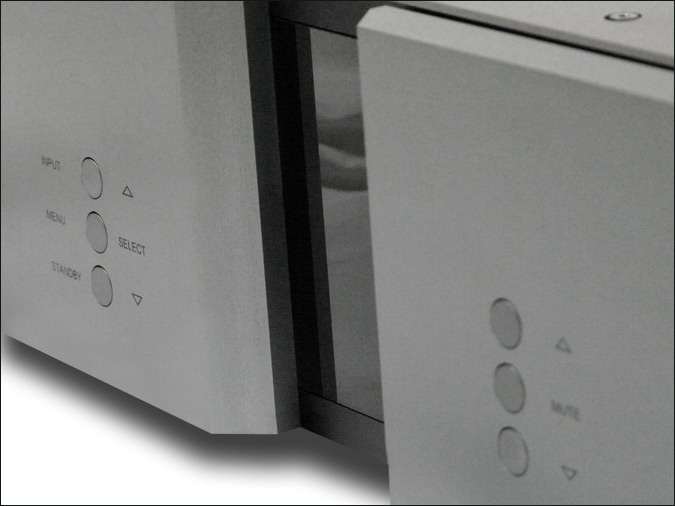
The Vitus SM-010 monos produced deep, natural, extended bass. The older Krell amps designed by Dan D’Agostino earned a reputation for their excellent bass. I thought they exaggerated the bass, separating it from the rest of the music. The Vitus monoblocks produced bass that was not a separate entity, but that underpinned the music’s vitality. Bass from the SM-010 monos was a smidgen on the wet side of natural. Instead of being dry and neutral, there was a perfect amount of dampness that made the bass sound right without overdoing it. For example, "Chant," from Fourplay’s Between the Sheets (CD, Warner Bros. 45340-2), opens with a large tom-tom stroke, followed by the bass line. Through my Piano Ceras, the bass on this cut was exemplary. I heard depth, the initial impact of stick against drumhead, and the rich tonality of the drum itself. In the past, I’ve heard this passage reproduced with a dry, lackluster quality that left the instrument sounding thin and dry. Instead, the Vitus-Tidal combo was extraordinary in reproducing the sound of a real drum, not just a neat facsimile.
Realism, however, is not a product of bass extension and tonality alone. There must also be resolution, immediacy, and dynamic contrast. My favorite album for testing for all of this is Joël Grare’s Paris • Istanbul • Shanghai (CD, Alpha 523). "Kapsberger Forever" begins with a solo guitar; the impacts of the player’s fingers on the strings are very clearly defined. Around 2:30 into the track there is a snap, then the sounds of a flamenco dancer’s castanets and tapping of her shoes on the floor. The Vitus amps allowed the woody character of shoes on floor, and the resonance and decay of those sounds in the room, to fully flesh themselves out. The transient attacks of the stomps and percussion were immediate, sharp, and focused, but still holistic and part of the music. The reproduction of the acoustic of the recording venue was faithful to its actual setting, instead of the inky blackness of a studio recording.
"Armory," from Daft Punk’s soundtrack album for the film Tron Legacy (CD, Walt Disney D000567202), produced some prodigious bass through the SM-010s. "Clockwork Apprentice," from Psycliq’s The Mathematician’s Riddle (16/44.1 WAV, Magnatune), came through with the wonderful rhythm, bass, power, and distortion that are parts of electronic music. The re-creation of the distortion, beats, and rhythm of "Cone Wars," from Kalotone’s Death of a Speaker (16/44.1 WAV, Magnatune), was astonishing. The soundstage was wide, deep, enveloping -- and entirely a product of the studio. The samples of real instruments were as real as I assume they can be; regardless, the whole thing had me grinning like an idiot more than worrying about the audiophile nuances.
My take
My main system has included several reference amps, but my favorite has been Tidal Audio’s Impact, a two-channel model ($26,000). I’ve learned that much of what audiophiles argue about are simply our preferences for a certain perspective on the music, and the Tidal reproduces music in a way that mirrors the way I prefer to listen to live music. At concerts, I prefer to sit mid-hall, where I’m able to get a better sonic overview of the event. I miss the overwhelming visceral impact of the bass and percussion one gets sitting close to the stage, but at my preferred seat I hear more musical nuances, and am able to hear the whole more clearly. Besides, I enjoy the unique acoustic properties of different venues. At a concert, the hall is as much a part of the musical experience as the music itself, and I want to experience it all. The Tidal Impact reproduces music so correctly in every aspect that I find it difficult to hear any fault in it. It is the best of all the current trendsetting amplifiers I’ve heard.
Comparing the Vituses to the Tidal was difficult. Both seated me at my favorite location, in the middle of the hall, and offered very similar sonic perspectives. Both sounded what I call natural -- I was always able to discern the characteristic signature of each unique instrument. Natural doesn’t necessarily mean lively, but rather a recorded sound that is precisely similar to that of an actual instrument played live. The power of each of these amps was more than sufficient for all but the most extreme listening sessions and demanding loudspeakers.
Where the amps diverged was in what I call "flesh tone." The Vitus SM-010s had a slightly more saturated flesh tone than the Tidal Impact. That increase in saturation affected the entire audioband, giving it a minuscule romantic tint that enhanced my listening. The Vitus offered a more personal flare that made the music slightly more engaging. The Tidal Impact let the music speak for itself with no help. Both amps were stunning. Both are reference amplifiers.
Conclusions
The words natural and real recur throughout my notes and this review. My listening sessions never lacked for anything, and I never wanted more. I always heard and enjoyed the music, not the electronics. I played everything I could get my hands on through the Vitus SM-010s, and they reproduced all of it beautifully. Could you ask for more? It’s one of the most complete, most natural-sounding amplifiers I have heard. I would like to own a pair!
Thông số kỹ thuật dòng âm thanh hi-end Vitus Audio Signature SM-010 Mono Amplifiers


















